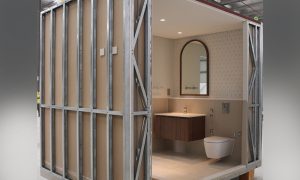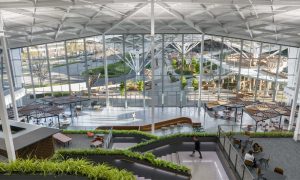Chris Brown on his new role at Woods Bagot in Dubai
Experienced architect lands position as Middle East design director

In a January 2015 interview with Middle East Consultant, Woods Bagot principal Julie Knight spoke of a “headline” name that was soon to be appointed design director for the company’s Dubai office. At the time of going to press, the mystery figure has been revealed as ex-HOK leader Chris Brown, a familiar face in the industry with 21 years of experience in the UK, Hong Kong, the US and the Middle East.
READ MORE: Architect Chris Brown appointed Mideast design director at Woods Bagot
After training at The Bartlett in London, Brown started working for RMJM in the same city before moving to the practice’s Hong Kong office. He subsequently worked for Foster + Partners in Hong Kong, Wilkinson Eyre Architects in London and then relocated to the Middle East in 1999 as head of architecture for RMJM in Dubai. The following year, Brown joined HOK to work as senior project architect for the six residential towers of Dubai Marina 1 for Emaar and later Dubai Festival City for Al Futtaim Group.
After a stint running a new Florida office for HKR, Brown decided to return to the Middle East and work for HOK, becoming vice president and practice leader of the region. During this second spell, he ran a team of over 30 architects and oversaw the delivery of a number of prestigious projects, including Msheireb Downtown Doha, Doha Marina Mall and the Change Initiative building in Dubai.
Middle East Consultant: What made you choose Woods Bagot?
Chris Brown: I chose Woods Bagot due to the quality of the design work and the diversity of the company overall. We use the term ‘design intelligence’ to describe the multi-faceted process of weaving together what is both art and science when it comes to project design. It also speaks to the gathering of intelligence, whether the research of our own studio here in Dubai or the input of experienced designers across sectors in our global studio. Woods Bagot allocates 2% of annual revenue to our global research arm. Research is the process, intelligence is the product. This collective intelligence leads to how we as a global practice inform tailored project approaches. The diversity aspect of Woods Bagot is also important. Many international practices are global; however, when you look across our network of directors, principals and senior staff, there is a genuine diversity in leadership background and design knowledge.
You were described by Julie Knight as a “headline” name. Do you think it was important for Woods Bagot to appoint someone well-known in the industry?
That is kind of Julie. I think what is important is being well-known for a track record rather than specifically having a profile. I think the work should speak for itself with the architect taking quiet pride in the client’s success, whether they are an end user or a commercial-led developer. A good case in point is the SAHMRI project in Adelaide, designed by Woods Bagot. It has delivered an award-winning design which has represented the client very well on the global stage.
This is my goal for the Dubai studio. Our work in the Middle East, as well as winning local design awards – which is a great plaudit – should aim to be as recognised within an increasingly global marketplace as it is in the local region. I think the challenge for the profession is to be delivering not simply the best work in the region, but the best work globally. There isn’t a lack of vision within the clients’ organisations, but together clients and consultants should be able to work more collaboratively to align those visions with the time and commercial constraints that many projects are subject to.
What project, in this region, are you most proud to have worked on?
I would choose two projects, both at opposite ends of the spectrum. Dubai Marina because of the entire design process, a fully engaged and passionate client, an excellent design team, a quality-led construction and the final product, which has served as a good benchmark for lifestyle residential in the region. The second project, at the other end of the scale but no less ambitious, is The Change Initiative. This was a brand conceived and developed in Dubai with a global sustainable outlook, again from a client with real vision. Both designs were exacting in their own ways, from the seamless integration on the Dubai Marina project to the sourcing of sustainable materials and gaining LEED credits on The Change Initiative building.
You have a lot of experience in the Middle East and around the world. What do you like most about working in the Middle East compared to other regions?
I would say it is the passion and vision that clients have for their projects, particularly at a leadership level. While that can make the designer’s life challenging, I believe most professionals here – if they took a step back from some of the daily pressures of the job – would see the incredible opportunities that we have. There is also an energy that comes from working with a variety of different cultures and experiences, and there seems to be an infectious desire to succeed. This could clearly be seen in the level of public engagement, for example, on the Expo 2020 bid. I also see a similar energy and diversity in our Dubai studio, and one of the great things about this role is the chance to mentor staff so that they genuinely enjoy and grow in what they are doing as creative professionals rather than just having a job.
We also enjoy very good access to clients in the region, and I think that early engagement is key to the success of a project. Clients are always welcome in our studio, and we notice that greater interaction can lead to more clearly defined goals and quicker resolution of design problems. It isn’t perfect, of course. Somebody reading this may ask, “What about more realistic design periods? Less fee cutting? More equitable contract terms?” They are all conversations a mature market must continue to have, so the industry evolves to serve our clients and regulates itself to reduce, or eliminate, poorly conceived and executed work.
Will you be championing the use of BIM?
Yes, I think it is critical. As a leading design practice, we continue with our implementation of BIM. We still aren’t seeing this as a universal requirement from clients, but regardless, we recommend its use. We see a greater appreciation among clients for the benefits of BIM; this will enable us to lead our industry rather than just follow a trend. BIM is not just a production tool, as some people may believe. It is a full design platform that brings to the table not just efficiencies in design, but a truly integrated design process where consultants are designing within each other’s virtual environments. It is far harder to ignore three- dimensional work in a shared environment than it is a traditional two-dimensional approach.
One thing I would like to see, however, is a realisation in the marketplace that there is a cost to BIM that must be balanced against savings made from reducing on-site clashes. It isn’t a quantum shift, but investment in BIM takes time, training and software, therefore the assumption that the consultant just absorbs those costs won’t provide the adoption rates or depths seen in the USA, UK and Australia.
You have a passion for façade design. Are fully glazed façades completely inappropriate for the desert, or can they still be sustainable?
Well-conceived high-performance glass façades have their place in building design, but I think regionally there is an over-reliance on skinning the building in glass. I suspect some of that is expediency by designers, coupled with the client’s desire to represent themselves with a modern materiality. As the market has matured, we are seeing far greater exploration of appropriate claddng types, whether that is the in-depth studies of creating a new architectural language at the Msheireb Downtown Doha, or the rich variety of cladding that brings The Beach project at JBR to life. Both are good examples of how far we as an industry have moved from fully glazed buildings. There is still a lot of work to be done, though, and I hope the industry embraces that challenge in the same way we are working with our clients on such issues.
READ MORE: Architect Chris Brown appointed Mideast design director at Woods Bagot
























